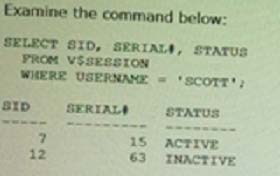Oracle 1z0-497 Exam Practice Questions (P. 1)
- Full Access (150 questions)
- Six months of Premium Access
- Access to one million comments
- Seamless ChatGPT Integration
- Ability to download PDF files
- Anki Flashcard files for revision
- No Captcha & No AdSense
- Advanced Exam Configuration
Question #1
Which statement about CDB architecture is true?
- AOracle-supplied metadata resides only in the root container.
- BA seed PDB can sometimes be opened for particular operations.
- CMultiple PDBs with the same name can reside in the same CDB.
- DA CDB can have an infinite number of PDBs.
- EYou can create common users in PDBs.
Correct Answer:
A
References:
A
References:
send
light_mode
delete
Question #2
As part of your Oracle Database 12c post-installation tasks, you run these commands:
Cd $ORACLE_HOME/bin -
srvctl stop database -d myDb
chopt enable dm
srvctl start database -d myDb
What does this do?
Cd $ORACLE_HOME/bin -
srvctl stop database -d myDb
chopt enable dm
srvctl start database -d myDb
What does this do?
- AIt enables the Oracle Data Mining option in your Oracle binary files.
- BIt creates the Fast Recovery Area disk group.
- CIt generates Client Static Library.
- DIt configures one of the Oracle user accounts.
- EIt configures Oracle Net Services.
- FIt configures Oracle Messaging Gateway.
Correct Answer:
A
References:
A
References:
send
light_mode
delete
Question #3
Exhibit below:

Which three statements are true about terminating a session?

Which three statements are true about terminating a session?
- AWithout any error, you can terminate the active session by executing:SQL> ALTER SYSTEM KILL SESSION '7, 15';
- BYou can terminate the active session by executing:SQL> ALTER SYSTEM KILL SESSION "7, 15';But you also get the error message:ORA-00028: your session has been killed
- CYou cannot terminate the active session. You have to wait until that session becomes inactive.
- DWithout any error, you can terminate the inactive session by executing:SQL> ALTER SYSTEM KILL SESSION '12, 63';
- EWhen an inactive session is killed, the status of that session remains visible in VSSESSION with status KILLED. The rowf the terminated session is removed from VSSESSION after the user attempts to use the session again.
- FYou cannot terminate the inactive session. You have to wait until that session becomes active again.
Correct Answer:
BDE
B (not A, Not C):
* You terminate a current session using the SQL statement ALTER SYSTEM KILL SESSION. The following statement terminates the session whose system identifier is 7 and serial number is 15:
* Terminating an Active Session
If a user session is processing a transaction (ACTIVE status) when you terminate the session, the transaction is rolled back and the user immediately receives the following message:
ORA-00028: your session has been killed
ALTER SYSTEM KILL SESSION '7,15';
E (not F): Terminating an Inactive Session
If the session is not making a SQL call to Oracle Database (is INACTIVE) when it is terminated, the ORA-00028 message is not returned immediately. The message is not returned until the user subsequently attempts to use the terminated session.
When an inactive session has been terminated, the STATUS of the session in the V$SESSION view is KILLED. The row for the terminated session is removed from V$SESSION after the user attempts to use the session again and receives the ORA-00028 message.
References:
BDE
B (not A, Not C):
* You terminate a current session using the SQL statement ALTER SYSTEM KILL SESSION. The following statement terminates the session whose system identifier is 7 and serial number is 15:
* Terminating an Active Session
If a user session is processing a transaction (ACTIVE status) when you terminate the session, the transaction is rolled back and the user immediately receives the following message:
ORA-00028: your session has been killed
ALTER SYSTEM KILL SESSION '7,15';
E (not F): Terminating an Inactive Session
If the session is not making a SQL call to Oracle Database (is INACTIVE) when it is terminated, the ORA-00028 message is not returned immediately. The message is not returned until the user subsequently attempts to use the terminated session.
When an inactive session has been terminated, the STATUS of the session in the V$SESSION view is KILLED. The row for the terminated session is removed from V$SESSION after the user attempts to use the session again and receives the ORA-00028 message.
References:
send
light_mode
delete
Question #4
Which two statements are true about shared server sessions?
- ANo Program Global Area (PGA) is allocated for shared server processes.
- BUser Global Area is stored in System Global Area (SGA).
- CShared SQL Area is allocated from Program Global Area (PGA).
- DPrivate SQL Area is allocated from Library Cache.
- ELarge Pool is used for SQL work areas.
Correct Answer:
BD
References:
BD
References:
send
light_mode
delete
Question #5
Which targets can be managed by using Enterprise Manager Cloud Control?
- AHosts and databases
- BHosts, databases, and application servers
- CApplication servers and web applications
- DDatabases, Oracle Management Server (OMS), and Oracle Management Repository (OMR)
- EDatabases, application servers, and web applications
- FHosts, databases, application servers, web applications, OMS, and OMR
Correct Answer:
F
References:
F
References:
send
light_mode
delete
All Pages
